A Total-Body Workout in 5 Easy Steps
Part 5: Abdominals
By Chelsea Cooper
If you didn't attain the elusive six-pack stomach in time for summer, don't give up yet. Get a complete abdominal workout with Chelsea Cooper, certified personal trainer, as she concludes her five-part series covering each of the major muscle zones. The abdominal area is probably the most talked about area for both men and women, but it is one of the most difficult areas to define correctly and effectively. The abs consist of the rectus abdominis, external oblique, internal oblique and transverse abdominis. The abdominal wall is made up of clusters of muscles separated by connective tissue. Ab exercises strengthen those clusters and burn off the surrounding fat. In extremely fit individuals, the clusters become visible, resulting in ridges or "washboard" abs. Your abs are a major component of your core, which is composed of the transversus abdominus, internal obliques, pelvic floor musculature, diaphragm, transversospinalis and multifidus. Researchers have found that individuals with chronic low back pain (85 percent of U.S. adults) have decreased use in these muscles. Working the abdominals promotes good posture and assists with athletic activities such as swinging a golf club or tennis racket. Strengthening the abdominal muscles and focusing on correct posture can vastly improve your body's shape. Abs can be done daily, but if there is any soreness the next day, you may want to rest for a day. Enjoy your workout! CORE EXERCISE TIP
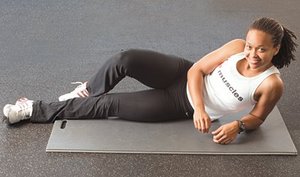 All photographs taken at Club No Mercy Intensity Performance Training Studio (www.clubnomercy.com) in Huntington Beach, Calif.
As with any exercise regimen, the key to these abdominal exercises is doing them right. Before engaging in an ab routine, practice concentrated flexing of the transversus abdominus and the interior and exterior obliques - the large muscles holding the spine and organs in place in the abdomen.
All photographs taken at Club No Mercy Intensity Performance Training Studio (www.clubnomercy.com) in Huntington Beach, Calif.
As with any exercise regimen, the key to these abdominal exercises is doing them right. Before engaging in an ab routine, practice concentrated flexing of the transversus abdominus and the interior and exterior obliques - the large muscles holding the spine and organs in place in the abdomen. The best way to get in touch with your abdominals is to pull your navel up and back toward your shoulder blades. Practice by sitting on a chair, isolating your shoulders and chest, pulling your navel up and back, and then releasing the muscles. Repeat 10 times and then as frequently as desired as you go about your day. This movement opens the neural pathways and helps the brain communicate with the muscle. You'll be astonished by the results you can achieve if you concentrate on keeping the muscles engaged during these exercises. CORE PRONE ISO ABS Getting Started 1 Lie face down on the floor with your feet together and your forearms on the ground. 2 Clench your hands into fists and place them at shoulder level. Movement 3 Squeeze your abs and glutes.
 Hold position for 35 to 40 seconds.
4 Lift your entire body off the ground until it forms a straight line from head to toe, resting on your forearms and toes.
Hold position for 35 to 40 seconds.
4 Lift your entire body off the ground until it forms a straight line from head to toe, resting on your forearms and toes. 5 Slowly return your body to the ground, keeping your chin tucked and your back flat. 6 Hold the position for 35 to 40 seconds and repeat. 7 To regress, perform the exercise with your knees on the floor. WORKOUT BASICS Repetitions And Sets: Same for both men and women; varies depending on individual goals (toning muscle vs. building muscle vs. building strength). Intensity: This is the percentage of your one-rep maximum (the maximum amount of weight you can lift at one time). For example, if your goal is to build muscle, you would perform repetitions using 70 percent to 75 percent of your one-rep maximum (see below). That means that if you can bench press 100 pounds one time, you would perform each repetition using a maximum of 75 pounds of weight. Toning Muscle (Strength/Endurance)
Sets: 2-3 /// Reps: 15-25 /// Intensity: 50% - 70% Building Muscle (Hypertrophy)
Sets: 3 /// Reps: 9-12 /// Intensity: 70% - 75% Strength Adaptation
Sets: 3-4 /// Reps: 6-8 /// Intensity: 75% - 85% SIDE-LYING ISO ABS
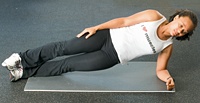
Draw in abs and squeeze glutes. Lift hips and legs off ground.
Getting Started 1 Lie on one side with your feet and legs stacked on top of each other and your forearm on the ground. Movement 2 Draw in your abs and squeeze your glutes. 3 Lift your hips and legs off the ground until the body forms a straight line from head to toe, resting on your forearm and feet. 4 Hold the position for 5 to 10 seconds. 5 Slowly lower your body to the ground. 6 Switch sides and repeat. ABDOMINALS
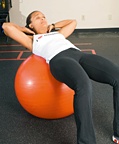 Lie with ball under your lower back.
BALL CRUNCH
Lie with ball under your lower back.
BALL CRUNCH Getting Started 1 Lie supine on a stability ball (with the ball under your low back), with your knees bent at a 90 degree angle. 2 Place your feet flat on the floor with your toes shoulder-width apart and pointing straight ahead. Allow your back to extend over the curve of the ball. Put your hands under your neck for support. Movement
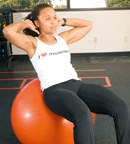 Keep abs drawn in tightly as you lower your upper body.
3 Draw in your abs and squeeze your glutes.
Keep abs drawn in tightly as you lower your upper body.
3 Draw in your abs and squeeze your glutes. 4 Slowly crunch your upper body forward, raising your shoulder blades off the ball and tucking chin to chest. 5 Slowly lower your upper body over the ball, keeping your abs drawn in tightly. 6 Repeat.
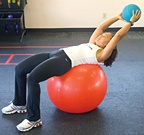 Keep feet flat on floor, shoulder-width apart.
LONG-LEVER BALL CRUNCH WITH MEDICINE BALL
Keep feet flat on floor, shoulder-width apart.
LONG-LEVER BALL CRUNCH WITH MEDICINE BALL Getting Started 1 Lie supine on a stability ball (with the ball under your low back) with your knees bent at a 90 degree angle. 2 Place your feet flat on the floor shoulder-width apart with your toes pointing straight ahead. Allow your back to extend over the curve of the ball. 3 Place your arms straight overhead holding the medicine ball.
 Keep arms directly overhead.
Movement
Keep arms directly overhead.
Movement 4 Draw in your abs and activate your glutes. 5 Quickly crunch your upper body forward. 6 Keep your arms directly overhead holding the medicine ball as you crunch. 7 Slowly lower your upper body over the ball, maintaining a drawn-in position. 8 Repeat.
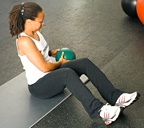 Keep feet from touching floor.
SEATED OBLIQUE TWISTS WITH MEDICINE BALL
Keep feet from touching floor.
SEATED OBLIQUE TWISTS WITH MEDICINE BALL Getting Started 1 Sit on the floor with your knees bent and your feet flat on the floor. 2 Raise your feet in the air just enough so they don't touch the floor. Movement
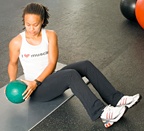 As you twist to each side, tap ball to ground.
3 Holding a medicine ball with both hands directly out in front of you, twist to your right and tap the ball on the ground.
As you twist to each side, tap ball to ground.
3 Holding a medicine ball with both hands directly out in front of you, twist to your right and tap the ball on the ground. 4 Quickly, but smoothly, turn to your left and tap the ball on the ground. 5 Repeat. This concludes my five-part series on the total-body workout. As you prepare for the holiday season, remember to keep yourself motivated by constantly challenging yourself to new levels. Good luck and stay fit!
Chelsea Cooper, MPA, CPT, is certified by the National Academy of Sports Medicine as a personal trainer, performance enhancement specialist, and rehab and exercise specialist. To learn more, visit www.trainwithchelsea.com.
Page printed from:
http://www.toyourhealth.com/mpacms/tyh/article.php?id=966&no_paginate=true&no_b=true
| 
